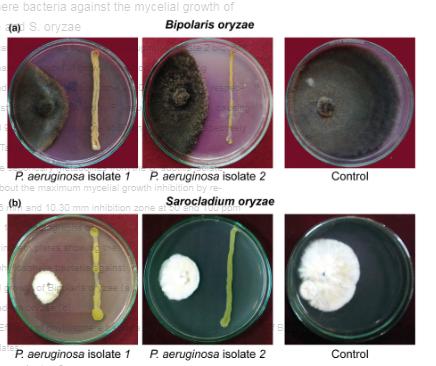Plant growth-promoting rhizobacteria (PGPR) and soil-inhabiting fungal antagonists such as Trichoderma are effective biocontrol agents for managing plant diseases caused by soil-borne pathogens. They are also shown to be effective in managing foliar pathogens to some extent by inducing induced systemic resistance. Rhizobacteria are soil-inhabiting microbes, particularly the rhizosphere (roots and their adjoining soil zone inhabited by unique microbiota due to the influence of root exudation). They may not adapt well in the phyllosphere (refers to above-ground parts of plants inhabited by microbiota) because the weather conditions and nutrient availability in the phyllosphere are dynamic and erratic . Thus, applying rhizosphere microbes for managing rice foliar diseases would not be successful.
Studies have been done on the isolation and characterization of phyllosphere antimicrobial agents for managing foliar diseases of crop plants. Unlike rhizobacteria, phyllosphere bacteria can withstand dynamic and adverse environmental conditions prevailing in the phyllosphere region. The major biotic and abiotic stresses encountered by the phyllosphere microbes are nutrient scarcity, desiccation, the effect of direct sunlight and UV irradiation and antimicrobial secondary metabolites produced by the plant .
The potential of exploiting antagonistic microorganisms of the phyllosphere in the biological control of plant foliar disease has been well documented. Predominant saprophytic and beneficial bacterial genera in the phyllosphere region are Methylobacterium, Sphingomonas spp., Bacillus spp. and Pseudomonas spp. . Saprophytic Methylobacterium and Sphingomonas spp. are abundant in naturally grown Arabidopsis thaliana and cultivated clover and canola plants. Methylobacteria, called pink-pigmented facultative methylotrophs (PPFM), are ubiquitous phyllosphere colonizers and exhibit a growth-promoting effect and drought stress tolerance on many crops . Bacterial strains such as Pseudomonas aeruginosa and Bacillus velezensis isolated from the phyllosphere region of the maize silk showed in vitro inhibitory effect against Fusarium verticillioides, which causes ear and stalk rot disease. They produced various cell wall degrading enzymes, namely proteases, chitinases and lipases, and reduced the fungal development in stored grains and stalk rot incidence under greenhouse-cultivated conditions . P. aeruginosa strains, namely DJ06 and B18, isolated from sugarcane rhizosphere, colonize sugarcane tissue endophytically. Its genome contains genes responsible for nitrogen fixation, ammonia metabolism, siderophore and indole acetic acid (IAA) production, phosphate metabolism and biocontrol activity. It increased sugarcane growth and photosynthetic leaf gas exchange .
Bipolaris oryzae and S. oryzae are the major pathogens inciting rice brown spot and sheath rot diseases, respectively, and causing damage on the foliar parts and grains. These two pathogens mainly infect and colonize the phyllosphere region, particularly seeds. Both these foliar pathogens never affect the root system and seldom survive in soil. It would be wise to utilize the phyllosphere antagonistic microorganisms for rice foliar disease management as phyllosphere microorganisms are more adaptive when compared to the rhizobacteria.
Reference: Sobanbabu, G., Oviya, R., Meena, B., Vijayasamundeeswari, A., Shanmugaiah, V., & Ramamoorthy, V. (2024). Evaluation of phyllosphere bacterial biocontrol agents for the suppression of rice foliar diseases. Journal of Phytopathology, 172, e13300. https://doi.org/10.1111/jph.13300
Error




